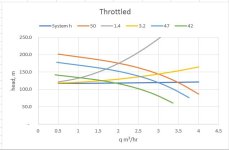rQx
Lifetime Supporting Member
Hi,
Just got a specification from a customer that said:
"The outlet flow to be controlled by:
- A combined flow rate/outlet pressure for all pumps (4pcs) (using the common PIT
and FIT)."
I've never heard of that I can use two PV to set a output. Is it possible? I will for sure talk with the customer what he wan't but always wan't to have good basic knowledge beforehand.
A follow up question is how to best control 4 pumps from one PV, but I leave that to another thread.
/Tim
Just got a specification from a customer that said:
"The outlet flow to be controlled by:
- A combined flow rate/outlet pressure for all pumps (4pcs) (using the common PIT
and FIT)."
I've never heard of that I can use two PV to set a output. Is it possible? I will for sure talk with the customer what he wan't but always wan't to have good basic knowledge beforehand.
A follow up question is how to best control 4 pumps from one PV, but I leave that to another thread.
/Tim








